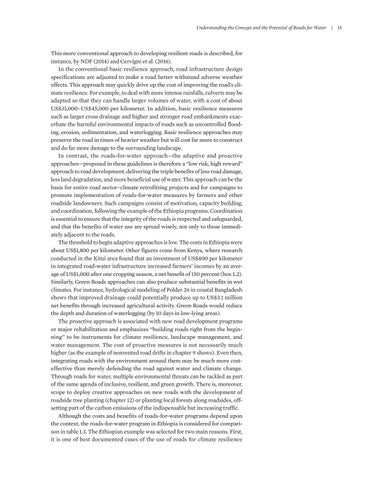Understanding the Concept and the Potential of Roads for Water | 15
This more conventional approach to developing resilient roads is described, for instance, by NDF (2014) and Cervigni et al. (2016). In the conventional basic resilience approach, road infrastructure design specifications are adjusted to make a road better withstand adverse weather effects. This approach may quickly drive up the cost of improving the road’s climate resilience. For example, to deal with more intense rainfalls, culverts may be adapted so that they can handle larger volumes of water, with a cost of about US$31,000–US$45,000 per kilometer. In addition, basic resilience measures such as larger cross drainage and higher and stronger road embankments exacerbate the harmful environmental impacts of roads such as uncontrolled flooding, erosion, sedimentation, and waterlogging. Basic resilience approaches may preserve the road in times of heavier weather but will cost far more to construct and do far more damage to the surrounding landscape. In contrast, the roads-for-water approach—the adaptive and proactive approaches—proposed in these guidelines is therefore a “low risk, high reward” approach to road development, delivering the triple benefits of less road damage, less land degradation, and more beneficial use of water. This approach can be the basis for entire road sector–climate retrofitting projects and for campaigns to promote implementation of roads-for-water measures by farmers and other roadside landowners. Such campaigns consist of motivation, capacity building, and coordination, following the example of the Ethiopia programs. Coordination is essential to ensure that the integrity of the roads is respected and safeguarded, and that the benefits of water use are spread wisely, not only to those immediately adjacent to the roads. The threshold to begin adaptive approaches is low. The costs in Ethiopia were about US$1,800 per kilometer. Other figures come from Kenya, where research conducted in the Kitui area found that an investment of US$400 per kilometer in integrated road-water infrastructure increased farmers’ incomes by an average of US$1,000 after one cropping season, a net benefit of 150 percent (box 1.2). Similarly, Green Roads approaches can also produce substantial benefits in wet climates. For instance, hydrological modeling of Polder 26 in coastal Bangladesh shows that improved drainage could potentially produce up to US$3.1 million net benefits through increased agricultural activity. Green Roads would reduce the depth and duration of waterlogging (by 10 days in low-lying areas). The proactive approach is associated with new road development programs or major rehabilitation and emphasizes “building roads right from the beginning” to be instruments for climate resilience, landscape management, and water management. The cost of proactive measures is not necessarily much higher (as the example of nonvented road drifts in chapter 9 shows). Even then, integrating roads with the environment around them may be much more cost- effective than merely defending the road against water and climate change. Through roads for water, multiple environmental threats can be tackled as part of the same agenda of inclusive, resilient, and green growth. There is, moreover, scope to deploy creative approaches on new roads with the development of roadside tree planting (chapter 12) or planting local forests along roadsides, offsetting part of the carbon emissions of the indispensable but increasing traffic. Although the costs and benefits of roads-for-water programs depend upon the context, the roads-for-water program in Ethiopia is considered for comparison in table 1.3. The Ethiopian example was selected for two main reasons. First, it is one of best documented cases of the use of roads for climate resilience







































